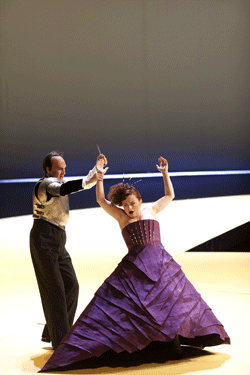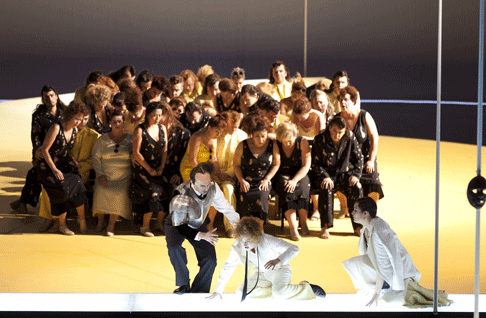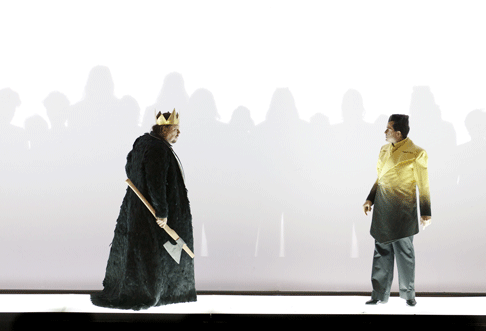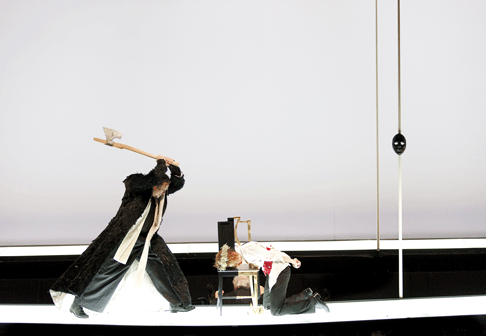![Michael Schade as Idomeneo and Stéphanie d’Oustrac as Idamante [Photo by Marco Borggreve courtesy of De Nederlandse Opera]](http://www.operatoday.com/idomeneo079.gif)
13 Dec 2011
Amsterdam’s Adventurous Idomeneo
Straight to the point: Netherlands Opera has mounted as luminous and emotionally engaging an Idomeneo as is imaginable.
English Touring Opera are delighted to announce a season of lyric monodramas to tour nationally from October to December. The season features music for solo singer and piano by Argento, Britten, Tippett and Shostakovich with a bold and inventive approach to making opera during social distancing.
This tenth of ten Live from London concerts was in fact a recorded live performance from California. It was no less enjoyable for that, and it was also uplifting to learn that this wasn’t in fact the ‘last’ LfL event that we will be able to enjoy, courtesy of VOCES8 and their fellow vocal ensembles (more below …).
Ever since Wigmore Hall announced their superb series of autumn concerts, all streamed live and available free of charge, I’d been looking forward to this song recital by Ian Bostridge and Imogen Cooper.
Although Stile Antico’s programme article for their Live from London recital introduced their selection from the many treasures of the English Renaissance in the context of the theological debates and upheavals of the Tudor and Elizabethan years, their performance was more evocative of private chamber music than of public liturgy.
Evidently, face masks don’t stifle appreciative “Bravo!”s. And, reducing audience numbers doesn’t lower the volume of such acclamations. For, the audience at Wigmore Hall gave soprano Elizabeth Llewellyn and pianist Simon Lepper a greatly deserved warm reception and hearty response following this lunchtime recital of late-Romantic song.
For this week’s Live from London vocal recital we moved from the home of VOCES8, St Anne and St Agnes in the City of London, to Kings Place, where The Sixteen - who have been associate artists at the venue for some time - presented a programme of music and words bound together by the theme of ‘reflection’.
'Such is your divine Disposation that both you excellently understand, and royally entertaine the Exercise of Musicke.’
‘And there was war in heaven: Michael and his angels fought against the dragon; and the dragon fought and his angels, And prevailed not; neither was their place found any more in heaven … that old serpent … Satan, which deceiveth the whole world: he was cast out into the earth, and his angels were cast out with him.’
There was never any doubt that the fifth of the twelve Met Stars Live in Concert broadcasts was going to be a palpably intense and vivid event, as well as a musically stunning and theatrically enervating experience.
‘Love’ was the theme for this Live from London performance by Apollo5. Given the complexity and diversity of that human emotion, and Apollo5’s reputation for versatility and diverse repertoire, ranging from Renaissance choral music to jazz, from contemporary classical works to popular song, it was no surprise that their programme spanned 500 years and several musical styles.
The Academy of St Martin in the Fields have titled their autumn series of eight concerts - which are taking place at 5pm and 7.30pm on two Saturdays each month at their home venue in Trafalgar Square, and being filmed for streaming the following Thursday - ‘re:connect’.
The London Symphony Orchestra opened their Autumn 2020 season with a homage to Oliver Knussen, who died at the age of 66 in July 2018. The programme traced a national musical lineage through the twentieth century, from Britten to Knussen, on to Mark-Anthony Turnage, and entwining the LSO and Rattle too.
With the Live from London digital vocal festival entering the second half of the series, the festival’s host, VOCES8, returned to their home at St Annes and St Agnes in the City of London to present a sequence of ‘Choral Dances’ - vocal music inspired by dance, embracing diverse genres from the Renaissance madrigal to swing jazz.
Just a few unison string wriggles from the opening of Mozart’s overture to Le nozze di Figaro are enough to make any opera-lover perch on the edge of their seat, in excited anticipation of the drama in music to come, so there could be no other curtain-raiser for this Gala Concert at the Royal Opera House, the latest instalment from ‘their House’ to ‘our houses’.
"Before the ending of the day, creator of all things, we pray that, with your accustomed mercy, you may watch over us."
The doors at The Metropolitan Opera will not open to live audiences until 2021 at the earliest, and the likelihood of normal operatic life resuming in cities around the world looks but a distant dream at present. But, while we may not be invited from our homes into the opera house for some time yet, with its free daily screenings of past productions and its pay-per-view Met Stars Live in Concert series, the Met continues to bring opera into our homes.
Music-making at this year’s Grange Festival Opera may have fallen silent in June and July, but the country house and extensive grounds of The Grange provided an ideal setting for a weekend of twelve specially conceived ‘promenade’ performances encompassing music and dance.
There’s a “slide of harmony” and “all the bones leave your body at that moment and you collapse to the floor, it’s so extraordinary.”
“Music for a while, shall all your cares beguile.”
The hum of bees rising from myriad scented blooms; gentle strains of birdsong; the cheerful chatter of picnickers beside a still lake; decorous thwacks of leather on willow; song and music floating through the warm evening air.
![Michael Schade as Idomeneo and Stéphanie d’Oustrac as Idamante [Photo by Marco Borggreve courtesy of De Nederlandse Opera]](http://www.operatoday.com/idomeneo079.gif)
Straight to the point: Netherlands Opera has mounted as luminous and emotionally engaging an Idomeneo as is imaginable.
It is difficult to adequately describe the stunning imagery that designer Karl-Ernst Herrmann has put on display with his vivid sets, costumes, and lights (for all I know, he designed the program and swept the stage as well). All of the technical elements embody a profound depth of spirit, are supremely informative, and visually engaging. His colossal floor plan puts a four-foot wide illuminated white pentagonal walkway around the orchestra and right up to the edge of the parterre, and adjoins to it at curtain-line a massive upstage golden-hued beach “peninsula” which narrows as it recedes, and is on a hydraulic that can tilt it towards us quite steeply when so desired. A lone, Arp-inspired rock far upstage seems to be awaiting a mermaid.
 Edgaras Montvidas as Arbace and Susan Gritton as Elettra
Edgaras Montvidas as Arbace and Susan Gritton as Elettra
The sides and top of the proscenium are defined by a large dove-grey “box” which is initially enclosed by a similar panel that covers the entire proscenium opening. This is used to magical effect as a shadow screen to intensify any number of key downstage moments with appropriate moving images, from very small to very large. Surprisingly, the entire massive panel was hinged at the top so its bottom could swing away from us and upward to disappear into the loft, not only revealing the expanse of sand upstage, but also creating ominous lighting effects as the shadow crosses the playing space like a guillotine blade.
Mr. Herrmann has accessorized the space with mysterious poles, each bearing a ritualistic symbol atop, at once suggesting Crete, the origins of dramatic performance itself, and an uncanny timelessness. Carrying out that primitive theme, artful masks for the chorus are judiciously deployed, sometimes worn, sometimes carried aloft by hand, sometimes held aloft atop poles. His costumes are as character-defining as you are likely to see in many a year of opera-going. Just look at the chorus (singing with gusto under Martin Wright’s tutelage) in one scene arrayed in a courtly set of butter-cup yellow double-breasted suits and gowns, in another barefoot and dressed down in generic and timeless black peasant wear, in yet another appearing like a bygone era’s stereotypical tourists.
 Edgaras Montvidas as Arbace, Stéphanie d’Oustrac Idamante, Judith van Wanroij as Ilia and Koor van De Nederlandse Opera
Edgaras Montvidas as Arbace, Stéphanie d’Oustrac Idamante, Judith van Wanroij as Ilia and Koor van De Nederlandse Opera
Overall, Herrmann the Costumer favors a baggy, loose fitting silhouette, almost suggesting children playing grown-ups. Idomeneo is in a generous white suit with a stray piece of shoulder armor, swaddled one time in a white felt cape and another in a consuming, weighty fur. And, yes he wears the standard issue, spiky European opera “crown.” Idamanate’s look seems inspired by a white sailor uniform, augmented by an unfettered vest and black tie. Neptune is in a mix and match of green pants, overcoat, and laurel wreath, part seaweed, part Emerald City. And best, Elettra is a diva assoluta, with a sort of violet/burgundy strapless push-up bodice top (decorated with vertical black-lacquered boning) and skirt of overlaid fabric that flares out like a funnel. Matching pumps, jacket and hat complete the fashionable persona. The hair design was no less masterful with quirky sweeps of tresses that rivaled a hood ornament on a Chrysler.
His lighting was no less affecting, with its cunning use of shadow play, and its color palette that ranged from stark white, to moody blue, to dusty orange, to vivid yellow. The diffuse sun projection was at times blood red, at others milky white, and during the raging storm, eclipsed by a brooding black disc. The lightening effect was truly unsettling, perfectly enhancing the panicked scattering of rag-clad choristers. The end of Act I was punctuated by a startling’ coup de theatre’ as the waning musical effects decrescendo’d to their last whimper when — BANG! — three giant prongs of Neptune’s trident came thrusting up violently from the stage floor. The audience was snapped to attention as one. So many exciting design choices, but then, what of the work of Herrmann the Director?
In tandem with his wife Ursel, Ehepaar Herrmann have crafted a fluid, constantly evolving series of stage pictures and plot development that are a joy to behold and too numerous to celebrate here. In addition to telling the story with serious dramatic purpose, they have managed to infuse some genuine wit and theatricality into the evening with the lurking appearances of a sometimes aggressive, sometimes bemused Nettuno. One common thread is having the sea-god continue to offer Idomeneo an ax with which to execute Idamante. However, his first entrance has him poking his head up over the ramp from the orchestra pit. Later, during a light hearted moment, he reappears there, places a platter with a cooked fish on the stage, and proceeds to filet and eat it!
 Michael Schade as Idomeneo and Dietmar Kerschbaum as Gran sacerdote di Nettuno
Michael Schade as Idomeneo and Dietmar Kerschbaum as Gran sacerdote di Nettuno
The Herrmann’s have done exemplary work with the movement and uses of the industrious chorus. One memorable effect saw the front panel raise to reveal a massive black monolith center of the ‘beach.’ It was only after Idomeneo grabbed (what turned out to be) a piece of the black cloth and pulled away the covering that we realized the monolith was the shoulder-to-shoulder chorus huddled beneath it. A caveat: while all of the action and confrontations were believable and while all of the arias were well internalized, the limitations of the traffic patterns on the ramp did provide challenges in variety of blocking, which were largely overcome. But none of this fruitful physicalization would count for anything had the musical side not matched it, and here Netherlands Opera really scored big.
In the treacherous title role, Michael Schade sang with his accustomed polish, his pleasing grainy tone sounding suave and responsive, and his florid passages secure and fleet. I have always found him rather reserved, even stiff, with his stage deportment, but on this outing Mr. Schade displayed a passion and ferocity that made this a truly memorable role assumption. Matching him, Susan Gritton revealed herself to be an Elettra ne plus ultra. Her richly glamorous tone, interpretive savvy, flawless technique, and ample gleaming fire power dominated every scene she was in (as she must). On the basis of her recent Sesto in Paris and now her assured Idamante here, Stephanie d’Oustrac seems to be laying claim to becoming the pre-eminent Mozart Mezzo of the Moment. Her pliant, bewitching instrument has in its arsenal tremulous outbursts, plangent laments, and utter security with rip-snorting trip hammer coloratura. And she cuts a believable figure in these pants roles, blessedly free of clichéd ‘manly’ posturing.
 Michael Schade as Idomeneo and Stéphanie d’Oustrac as Idamante
Michael Schade as Idomeneo and Stéphanie d’Oustrac as Idamante
Having previously quite enjoyed Judith van Wanroij’s pure, silvery soprano in Monteverdi on this stage, I found my admiration well founded since she delivered a haunting, sympathetic Ilia. A pre-performance announcement in Dutch was made that I didn’t really follow, and when I asked about it at intermission I found that the singer performing Arbace was “indisposed.” I had actually already been mightily impressed by Edgardas Montvides for his vibrant tone and convincing delivery. What must he sound like when he is well!? All of the smaller roles were nicely essayed, particularly the delightfully warm soprano of diminutive Fang Fang Kong as a featured Cretan.
John Nelson led an idiomatic, highly detailed reading in the pit, eliciting vibrant colors and textures that made a potent case for Mozart’s opus. Noteworthy, too, were the wonderful contributions from Peter Lockwood with his aptly inventive playing of the continuo keyboard in tandem with the refined cello work from Herre-Jan Stergenga. When all the theatrical and musical planets align as they did with Netherlands Opera’s Idomeneo, you really are wholly drawn into an artistic experience that is, well, out of this world.
James Sohre